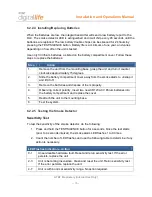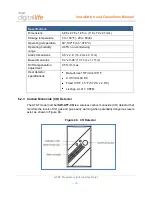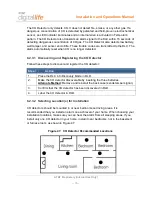
Installation and Operations Manual
AT&T Proprietary (Internal Use Only)
—86—
Step
Action
3.
Using an 11/16 drill bit, slowly drill a hole for the magnet.
4.
Drill the mating hole for the sensor. Use either the flush mount cap for a snug
fit or a flanged cap for a door or window frame.
5.
Remove the round transmitter cap.
6.
Carefully remove the transmitter assembly from its housing.
7.
Install the battery, making sure that you observe the battery polarity. The
positive polarity (+) is nearest the printed circuit board.
NOTE
: If you are mounting the transmitter on the top portion of the door jam,
go to step 8. Otherwise, go to step 11.
8.
Replace the transmitter cap with the cap from the accessories package that
includes the two screw holes.
9.
Slide the transmitter assembly into the 7/8 inch hole.
10.
Using the screws provided, secure the assembly into the door jam.
11.
If you are mounting the transmitter into the side of the door jam, proceed as
follows. Slide the transmitter assembly into the 7/8 inch hole.
6.2.5.4 Mounting the Magnet Assembly
The integral magnet assembly must be aligned with the RDW transmitter assembly.
1. Locate the mark previously made for the magnet position.
2. Drill a 3/4 inch hole into the door or window.
3. Insert the magnet assembly into the drilled hole.
6.2.5.5 Installing/Replacing Battery
The RDW sensor requires one 3-Volt CR2 Lithium Battery. Follow these steps to install
or replace the batteries:
Step
Action
1.
Remove the transmitter assembly from the door or windows jams (if installed.)
2.
Using a flathead screwdriver, pop off the top cap.
3.
Carefully remove the transmitter circuit board from its housing.
4.
Remove the depleted battery and dispose of it as required by local laws.
5.
Insert the replacement battery paying careful attention to the battery polarity.
The positive polarity (+) is the side nearest the transmitter printed circuit board,
as shown in Figure 54.







































